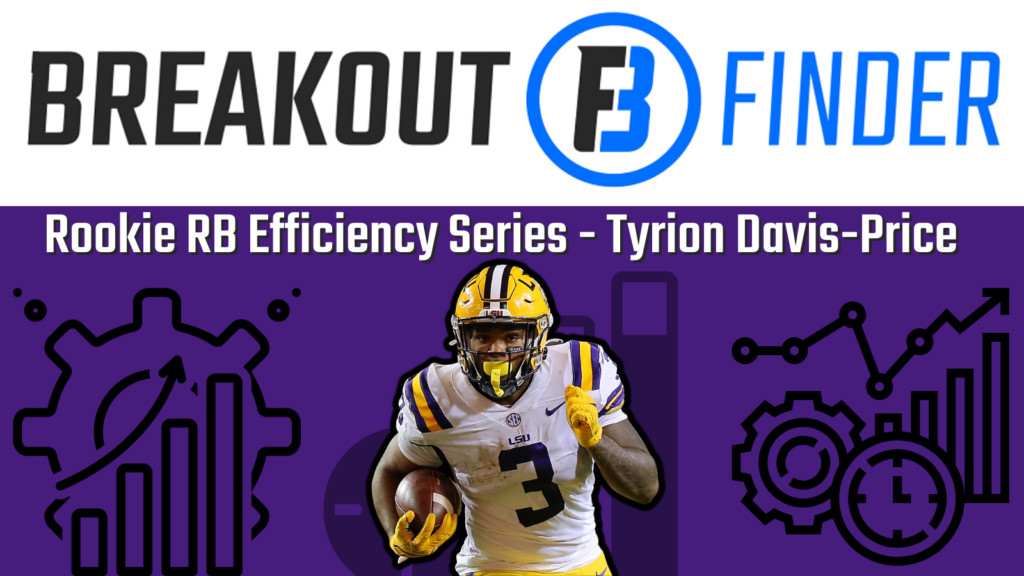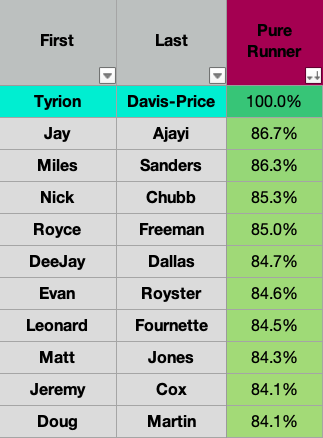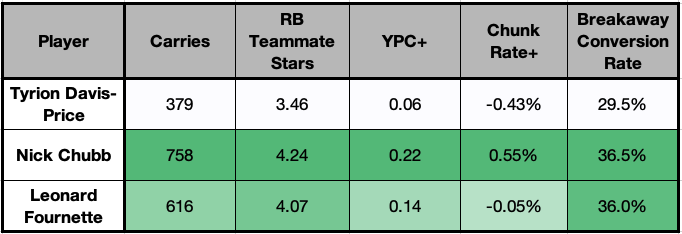LSU’s Tyrion Davis-Price is the next subject in a series in which I evaluate 2022 rookie running backs solely on their ability to run the ball. The Breakout Finder installments can be found here. The PlayerProfiler installments can be found here. If you happened to already catch those and don’t need a refresher on my methodology, feel free to skip to the player-focused analysis.

LSU’s Tyrion Davis-Price was a highly-touted 4-star recruit back in the class of 2019. But it’s been a relatively disappointing few years since then. He sat behind Clyde Edwards-Helaire as a true freshman, then led a committee as a sophomore. All before securing the clear lead back role in the Tiger offense in 2021. In his lone season as the sole starter at running back, Davis-Price posted a 20.0-percent Dominator Rating. A 38th-percentile mark among third-year players who would go on to be drafted since 2007. As a runner, his performance was a bit of a mixed bag. Let’s take a look.
The Metrics
While he carried the ball only 379 times in his college career (34th-percentile), Tyrion Davis-Price was listed at 6-1 and 223-pounds this last year at LSU and likely wouldn’t have any issue handling heavier volume in a hypothetical workhorse role.
As a part-time player in 2019 and 2020, Davis-Price posted a -0.57 YPC+ mark and was more than 4-percent worse than his teammates in Chunk Rate both seasons. His performances in those metrics would land in the 14th and 10th-percentiles, respectively. Upon taking over as the starter, he was a bit better. He improved his YPC+ to a positive 0.57 and outdid his teammates in Chunk Rate by 2.65-percent. Good for the 53rd and 61st-percentiles, respectively.
For his career, Davis-Price had a 0.06 (31st-percentile) YPC+ and a -0.43-percent (35th-percentile) Chunk Rate+.
He did have a tougher path to his efficiency than other LSU running backs. He saw o.11 more defenders in the box on average than they did, a 66th-percentile discrepancy. Given those box counts, he was still far less efficient overall than his teammates, but did run with greater consistency. He owns a 90.6-percent (7th-percentile) Box-Adjusted Efficiency Rating and a 4.0-percent (68th-percentile) Relative Success Rate. All of these metrics are relative to teammates who averaged a collective 3.46-star rating (60th-percentile) as high school recruits.
Davis-Price also did not offer much value as a breakaway threat. He converted just a 44th-percentile amount of his 10-yard gains into splash plays of 20 yards or more.
Rushing Efficiency Score and Comps
Given all of the non-BAE metrics touched on above (in addition to overall team quality, offensive line play, and strength of opponent), Tyrion Davis-Price earns a 32.6 out of 100 in my process’ Rushing Efficiency Score composite rating. In a composite that accounts for the box count data, he earns a 40.9 grade.
Using the same metrics that go into the main Rushing Efficiency composite (as well as physical measurables), I am able to generate similarity scores between current and historical prospects to find comps for players as pure runners. Assuming he runs a 4.50 40-yard dash at a projected 6-0 and 228-pounds, his most comparable players are the following:

I’m very surprised by the amount of talented players in this comps list. Guys like Doug Martin, Jay Ajayi, and Miles Sanders are kind of whatever; given that their NFL success has been more circumstantial than fueled by their having some sort of special talent. But, Nick Chubb and Leonard Fournette are legitimate NFL talents with legitimate similarities to Davis-Price. And you better believe I’m still keeping the light on for Royce Freeman. They’re all of similar size, played at similarly-tiered colleges, and were similarly efficient (in some ways) relative to quality teammates.
Some More Context
The differences between those players and Davis-Price are key, though. First of all, Chubb and Fournette were high-volume runners nearly from the moment they stepped on their respective college campuses. Davis-Price only became that after sitting behind CEH for a year and then failing to truly beat out an assortment of other dudes in year two. Chubb and Fournette were also legitimate big-play threats in college, which Davis-Price was not. And, while some of the minutiae of their efficiency profiles are comparable, Chubb and Fournette had better overall numbers. Contrasted with the composite score of 32.6 that Davis-Price earns in my aggregating of the relevant metrics, Chubb and Fournette earned a 62.3 and a 58.0, respectively. He is simply a much worse version of the kind of player that those two are. Here are the rushing profiles of those three guys side-by-side:

Last Word
Tyrion Davis-Price looks like a big, prototype runner in the NFL, but he doesn’t have the skillset or college resumé to back up the superficialities. In the mold of Matt Jones or Jeremy Cox, he’s a big ol’ JAG.
